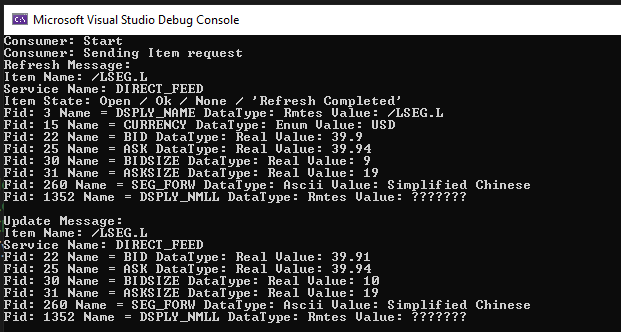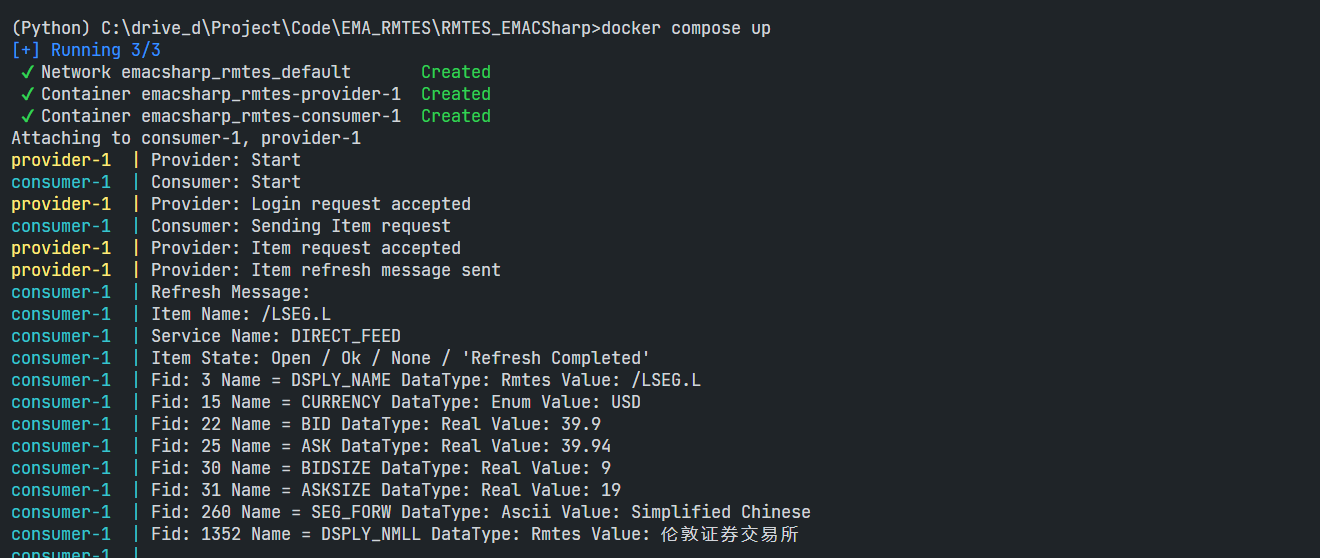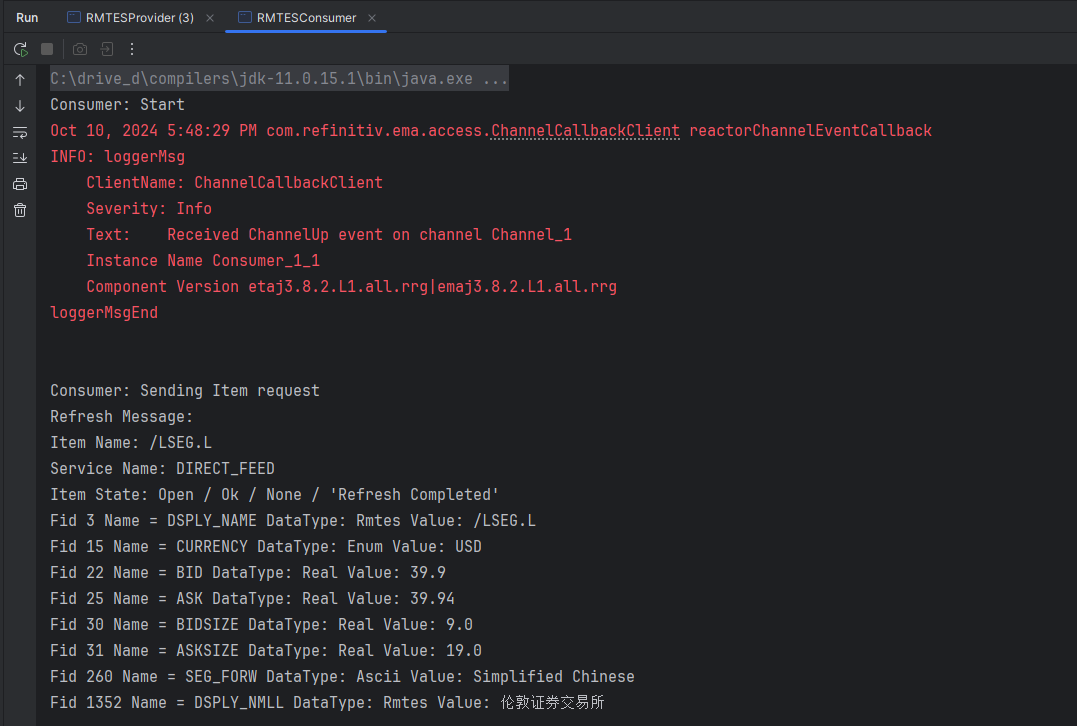
Overview
Last Updated: April 2025
This article is a sequel to my colleague's Encoding and Decoding non-ASCII text using EMA and RFA C++/.NET. While that article describes how to encoding and decoding RMTES String data with the EMA C++ and the legacy RFA C++ APIs, the part two article shows the same process with the strategic EMA C# and EMA Java APIs.
I am demonstrating with RTSDK Java 2.2.3.L1 (EMA Java 3.8.3.0) and RTSDK C# 2.2.3.L1 (EMA C# 3.3.1.1).
RMTES Recap: What is RMTES?
There are some fields on the data dictionary (RDMFieldDictionary) that use the RMTES_String data type. This data type is designed to use with local language (non-ASCII text) such as Chinese, Korean, Thai, etc.
Example RMTES_String field:
DSPLY_NMLL "LCL LANG DSP NM" 1352 NULL ALPHANUMERIC 32 RMTES_STRING 32
RMTES Encoding
RMTES uses ISO 2022 escape sequences to select the character sets used. RMTES provides support for Reuters Basic Character Set (RBCS), UTF-8, Japanese Latin and Katakana (JIS C 6220 - 1969), Japanese Kanji (JIS X 0208 - 1990), and Chinese National Standard (CNS 11643-1986). RMTES also supports sequences for character repetition and sequences for partial updates.
Although there is no open RMTES encoder library provide for external developers, they can use the switching function provided for encoding RMTES string and switching from default ISO 2022 scheme to UTF-8 character set. That mean developers can use the UTF-8 character set to publish data for RMTES field type and then publish that string to the Real-Time system.
The switching function uses the first three bytes of the text as the escape sequence. The Real-Time Distribution System components use them for the text encoded with UTF-8. Those three bytes are 1B 25 30 as follows:
0x1B 0x25 0x30
An application can prepend 0x1B, 0x25, 0x30 to the UTF8 string and encode that way as an RMTES type. The escape sequence characters indicate to the RMTES parser or decoder that it’s supposed to be a UTF-8 string.
Please note that you need to be very careful with using that three-byte string, as it can cause the UTF-8 string to be longer than the cached dictionary values which are the size of RWF LEN column in a byte from RDMFieldDictionary. It can cause display issues if they’re going through the infra.
The non-ASCII character such as Chinese, Thai, Japanese and Korea language can be used UTF-8 character set, therefore, the application can use this way to encode the non-ASCII text instead. We will talk about the implementation in EMA C# and Java in the next section.
That covers the overview of RMTES data.
Prerequisite
Before I am going further, there is some prerequisite, dependencies, and libraries that the project is needed.
Docker Desktop Application
You can build and run each EMA C#/Java Provider and Consumer applications manually. However, it is easier to build and run with a simple docker compose command.
The Docker Desktop application is required to run all projects.
Internet Access
The EMA C# library available on the NuGet repository. While the EMA Java library is also available on the Maven Central repository.
This project download the EMA libraries over internet to build and run applications.
EMA C# Projects Prerequisite
.NET SDK
Firstly, you need .NET 8 SDK.
Please check How to check that .NET is already installed to verify installed .NET versions on your machine.
Visual Studio Code or Visual Studio IDE
The EMA C# projects support both VS Code editor and Visual Studio 2022 IDE.
EMA Java Project Prerequisite
Java SDK
For the Java project, you need Java SDK version 11, 17, or 21 (either Oracle JDK or OpenJDK).
Apache
The Java project uses Apache Maven as a project build automation tool.
IntelliJ IDEA
The EMA Java project supports IntelliJ IDEA IDE. However, any IDEs or Editors that support Maven Standard Directory Layout should be fine.
That covers the prerequisite of this RMTES project.
Publishing non-ASCII RMTES string in EMA application
So, now let’s look at how to publish the RMTES string data to downstream applications (either consumers or RTDS components).
Like my colleague's statement on the original article, an OMM Publisher developers can just add the UTF-8 string with the three bytes escape sequences to the FieldList object and then publish that data to the wire.
EMA C#
So, I will start off with the EMA C# OMM Provider application. The code is based on the EMA C# 130_MP_UserDispatch example.
I am modifying the AppClientProvider class ProcessMarketPriceRequest() method to publish the following text data to downstream components:
- the UTF-8 string via the DSPLY_NMLL field (FID 1352)
- the ASCII string via the SEG_FORW field (FID 260) as a meaning of DSPLY_NMLL data
The first step is to create a variable to store our UTF-8 string. And then prepend the 1B 25 30 escape sequence bytes to the UTF-8 string bytes array.
void ProcessMarketPriceRequest(RequestMsg reqMsg, IOmmProviderEvent providerEvent)
{
// ...
string utf8String = "伦敦证券交易所"; //Simplified Chinese
// Set a byte array of RMTES three bytes escape sequence
var bytesOne = new byte[] { 0x1B, 0x25, 0x30 };
// Convert our UTF8 String to a byte array
var bytesTwo = Encoding.UTF8.GetBytes(utf8String);
// prepend 0x1B, 0x25, 0x30 to the UTF8 string
byte[] byteRMTES = new byte[bytesOne.Length + bytesTwo.Length];
for (int i = 0; i < byteRMTES.Length; ++i)
{
byteRMTES[i] = i < bytesOne.Length ? bytesOne[i] : bytesTwo[i - bytesOne.Length];
}
}
Now, the byteRMTES variable stores the RMTES data and ready to publish to downstream applications.
The EMA C# FieldList object supports RMTES via the AddRmtes(int fieldId,EmaBuffer value) method, so an application needs to convert the bytesRMTES variable to the EmaBuffer object before construct the Refresh Response message payload.
// Convert the RMTES byte array string into a EmaBuffer
EmaBuffer emaBuffer = new();
emaBuffer.CopyFrom(byteRMTES);
FieldList fieldList = new FieldList();
//Additional ENUM, REAL fields
// ...
fieldList.AddAscii(260, "Simplified Chinese"); //SEG_FORW
fieldList.AddRmtes(1352, emaBuffer); //DSPLY_NMLL
providerEvent.Provider.Submit(new RefreshMsg()
.Name(reqMsg.Name()).ServiceName(reqMsg.ServiceName())
.Solicited(true)
.State(OmmState.StreamStates.OPEN, OmmState.DataStates.OK, OmmState.StatusCodes.NONE, "Refresh Completed")
.Payload(fieldList.Complete()).Complete(true),
providerEvent.Handle);
ItemHandle = providerEvent.Handle;
I also modified the Provider.cs file to send UTF-8 String for Simplified Chinese, Traditional Chinese, Japanese, Korean, and Thai languages messages randomly to downstream applications via the Update messages.
static void Main(string[] args)
{
..
string[] utf8StringArray = { "伦敦证券交易所", "倫敦證券交易所", "ロンドン証券取引所", "런던 증권 거래소", "ตลาดหลักทรัพย์ลอนดอน" };
string[] asciiStringArray = { "Simplified Chinese", "Traditional Chinese", "Japanese", "Korean", "Thai" };
Random rnd = new Random();
int index_lang = 0;
EmaBuffer emaBuffer = new();
while (DateTime.Now < endTime)
{
provider.Dispatch(1000);
index_lang = rnd.Next(5);
emaBuffer = EncodeRMTES(utf8StringArray[index_lang], emaBuffer);
fieldList.Clear();
// ...
fieldList.AddAscii(260, asciiStringArray[index_lang]); //SEG_FORW
fieldList.AddRmtes(1352, emaBuffer); //DSPLY_NMLL
provider.Submit(new UpdateMsg().Payload(fieldList.Complete()), appClient.ItemHandle);
count++;
// ...
}
..
}
// Create RMTES ByteBuffer with the input UTF8 String for the update messages
private static EmaBuffer EncodeRMTES (string utf8Message, EmaBuffer emaBuffer)
{
// Set a byte array of RMTES three bytes escape sequence
var bytesOne = new byte[] { 0x1B, 0x25, 0x30 };
// Convert our UTF8 String to a byte array
var bytesTwo = Encoding.UTF8.GetBytes(utf8Message);
// prepend 0x1B, 0x25, 0x30 to the UTF8 string
byte[] byteRMTES = new byte[bytesOne.Length + bytesTwo.Length];
for (int i = 0; i < byteRMTES.Length; ++i)
{
byteRMTES[i] = i < bytesOne.Length ? bytesOne[i] : bytesTwo[i - bytesOne.Length];
}
// Convert the RMTES byte array string into a ByteBuffer
emaBuffer.Clear();
return emaBuffer.CopyFrom(byteRMTES);
}
That covers the EMA C# for publishing RMTES data.
EMA Java
Moving on to the EMA Java. The code is based on the EMA Java ex130_MP_UserDispatch example which is equivalent to the EMA C# API. The modification on the RMTESProvider.java has the same business logic as the EMA C# Provider.cs example explained above.
The first step is to create a variable to store our UTF-8 string. And then prepend the 1B 25 30 escape sequence bytes to the UTF-8 string bytes array.
void processMarketPriceRequest(ReqMsg reqMsg, OmmProviderEvent event) {
// ...
String utf8String = "伦敦证券交易所";
// Set a byte array of RMTES three bytes escape sequence
byte[] bytesOne = {0x1B, 0x25, 0x30};
// Convert our UTF8 String to a byte array
byte[] bytesTwo = utf8String.getBytes();
// prepend 0x1B, 0x25, 0x30 to the UTF8 string
byte[] byteRMTES = new byte[bytesOne.length + bytesTwo.length];
ByteBuffer buffer = ByteBuffer.wrap(byteRMTES);
buffer.put(bytesOne);
buffer.put(bytesTwo);
byteRMTES = buffer.array();
}
The EMA Java FieldList object supports RMTES via the FieldEntry.rmtes(int fieldId, java.nio.ByteBuffer value) method, so an application needs to convert the bytesRMTES variable to the Java ByteBuffer object before construct the Refresh Response message payload.
// Convert the RMTES byte array string into a ByteBuffer
ByteBuffer emaBuffer = ByteBuffer.wrap(byteRMTES);
//Set Refresh Response OMM FieldList data
FieldList fieldList = EmaFactory.createFieldList();
//Additional ENUM, REAL fields
fieldList.add(EmaFactory.createFieldEntry().ascii(260, "Simplified Chinese")); //SEG_FORW
fieldList.add(EmaFactory.createFieldEntry().rmtes(1352, emaBuffer)); //DSPLY_NMLL
event.provider().submit(EmaFactory.createRefreshMsg().serviceName(reqMsg.serviceName()).name(reqMsg.name()).
state(OmmState.StreamState.OPEN, OmmState.DataState.OK, OmmState.StatusCode.NONE, "Refresh Completed").solicited(true).
payload(fieldList).complete(true), event.handle());
itemHandle = event.handle();
The RMTESProvider.java file also has been added a logic to send UTF-8 String for Simplified Chinese, Traditional Chinese, Japanese, Korean, and Thai languages messages randomly to downstream applications via the Update messages. The source code logic is the same as the EMA C# API. Please find more detail on the source code project on the GitHub repository.
That covers how to publish the RMTES string data.
Decoding non-ASCII RMTES string in EMA Consumer application
That brings us to how to decode the RMTES data on the consumer side. The EMA APIs (C++, Java, and C#) generally provided RMTES converter or parser interface for converting the encoded RMTES string payload received as part of the OMM data to a Unicode string. It helps display news in international languages with UCS2 format or transfer data through the network in ISO 2022 and UTF-8. The following section will provide a guideline for applications that want to display non-ASCII string correctly.
Displaying non-ASCII RMTES string in EMA C# Consumer application
Let’s start with the EMA C# consumer application. The Consumer Consumer.cs class is based on the EMA C# 310_MP_Rmtes and 360_MP_View examples.
To decode incoming RMTES data, an application can use the FieldEntry.OmmRmtesValue() method to get the OMM RMTES data:
// Consumer.cs
// Decoding FieldEntry
foreach (FieldEntry fieldEntry in fieldList)
{
Console.Write($"Fid: {fieldEntry.FieldId} Name = {fieldEntry.Name} DataType: {DataType.AsString(fieldEntry.Load!.DataType)} Value: ");
if (Data.DataCode.BLANK == fieldEntry.Code)
Console.WriteLine(" blank");
else
// Handle each data type (fits to the type of requests FIDs)
switch (fieldEntry.LoadType)
{
// ...
case DataTypes.RMTES:
Console.WriteLine(fieldEntry.OmmRmtesValue());
break;
default:
Console.WriteLine();
break;
}
}
If an application needs to work with partial RMTES updates, developers can cache RMTES data from the FieldEntry.OmmRmtesValue() method to the RmtesBuffer objects and apply all received changes to them. Please refer to EMA C# Documents for more information about RmtesBuffer class.
// Consumer.cs
// Decoding FieldEntry
private readonly RmtesBuffer rmtesBuffer = new(new byte[0]);
//..
// In the below loop partial updates for the specific field of RMTES type are handled.
// Note that in case it is necessary to handle partial updates for multiple fields,
// the application has to cache each RMTES string in a separate RmtesBuffer
// (e.g., use a hashmap to track RmtesBuffer instances corresponding to specific FIDs)
// and apply the updates accordingly.
foreach (FieldEntry fieldEntry in fieldList)
{
// ...
if (Data.DataCode.BLANK == fieldEntry.Code)
Console.WriteLine(" blank");
else
// Handle each data type (fits to the type of requests FIDs)
switch (fieldEntry.LoadType)
{
// ...
case DataTypes.RMTES:
// If an application just cache RMTESBuffer objects and apply all received changes to them.
Console.WriteLine(rmtesBuffer.Apply(fieldEntry.OmmRmtesValue()).ToString());
break;
default:
Console.WriteLine();
break;
}
}
Displaying non-ASCII RMTES string in EMA Java Consumer application
My next point is the EMA Java API. The Consumer RMTESConsumer.java class is based on the EMA Java ex310_MP_Rmtes and ex360_MP_View examples.
Developers can use the EMA Java FieldEntry.rmtes() method to decode incoming RMTES data as follows.
// RMTESConsumer.java
// Decoding FieldEntry
fieldList.forEach(fieldEntry -> {
//..
if (Data.DataCode.BLANK == fieldEntry.code())
System.out.println(" blank");
else
//Handle each data type (fits to the type of requests FIDs)
switch (fieldEntry.loadType()) {
//...
case DataType.DataTypes.RMTES:
System.out.println(fieldEntry.rmtes());
break;
default:
System.out.println();
break;
}
});
Like the C# counterpart, you can cache RMTES data from the FieldEntry.rmtes() method to the RmtesBuffer objects and apply all received changes to them if an application needs to work with partial RMTES updates.
If an application needs to work with partial RMTES updates, developers can cache RMTES data from the FieldEntry.OmmRmtesValue() method to the RmtesBuffer objects and apply all received changes to them. Please refer to EMA Java Documents for more information about RmtesBuffer class.
// RMTESConsumer.java
// Decoding FieldEntry
import com.refinitiv.ema.access.RmtesBuffer;
private RmtesBuffer rmtesBuffer = EmaFactory.createRmtesBuffer();
//...
// In the below loop partial updates for the specific field of RMTES type are handled.
// Note that in case it is necessary to handle partial updates for multiple fields,
// the application has to cache each RMTES string in a separate RmtesBuffer
// (e.g., use a hashmap to track RmtesBuffer instances corresponding to specific FIDs)
// and apply the updates accordingly.
fieldList.forEach(fieldEntry -> {
//..
if (Data.DataCode.BLANK == fieldEntry.code())
System.out.println(" blank");
else
//Handle each data type (fits to the type of requests FIDs)
switch (fieldEntry.loadType()) {
//...
case DataType.DataTypes.RMTES:
// If an application just cache RMTESBuffer objects and apply all received changes to them.
System.out.println((rmtesBuffer.apply(fieldEntry.rmtes())).toString());
break;
default:
System.out.println();
break;
}
});
Example Decoding Results
The run result belows are from the EMA C# projects.
$>docker compose up
[+] Running 3/3
✔ Network emacsharp_rmtes_default Created 0.1s
✔ Container emacsharp_rmtes-provider-1 Created 0.1s
✔ Container emacsharp_rmtes-consumer-1 Created 0.1s
Attaching to consumer-1, provider-1
provider-1 | Provider: Start
consumer-1 | Consumer: Start
provider-1 | Provider: Login request accepted
consumer-1 | Consumer: Sending Item request
provider-1 | Provider: Item request accepted
provider-1 | Provider: Item refresh message sent
consumer-1 | Refresh Message:
consumer-1 | Item Name: /LSEG.L
consumer-1 | Service Name: DIRECT_FEED
consumer-1 | Item State: Open / Ok / None / 'Refresh Completed'
consumer-1 | Fid: 3 Name = DSPLY_NAME DataType: Rmtes Value: /LSEG.L
consumer-1 | Fid: 15 Name = CURRENCY DataType: Enum Value: USD
consumer-1 | Fid: 22 Name = BID DataType: Real Value: 39.9
consumer-1 | Fid: 25 Name = ASK DataType: Real Value: 39.94
consumer-1 | Fid: 30 Name = BIDSIZE DataType: Real Value: 9
consumer-1 | Fid: 31 Name = ASKSIZE DataType: Real Value: 19
consumer-1 | Fid: 260 Name = SEG_FORW DataType: Ascii Value: Simplified Chinese
consumer-1 | Fid: 1352 Name = DSPLY_NMLL DataType: Rmtes Value: 伦敦证券交易所
consumer-1 |
provider-1 | Provider: Sending Item update messages
consumer-1 | Update Message:
consumer-1 | Item Name: /LSEG.L
consumer-1 | Service Name: DIRECT_FEED
consumer-1 | Fid: 22 Name = BID DataType: Real Value: 39.91
consumer-1 | Fid: 25 Name = ASK DataType: Real Value: 39.94
consumer-1 | Fid: 30 Name = BIDSIZE DataType: Real Value: 10
consumer-1 | Fid: 31 Name = ASKSIZE DataType: Real Value: 19
consumer-1 | Fid: 260 Name = SEG_FORW DataType: Ascii Value: Japanese
consumer-1 | Fid: 1352 Name = DSPLY_NMLL DataType: Rmtes Value: ロンドン証券取引所
consumer-1 |
consumer-1 | Update Message:
consumer-1 | Item Name: /LSEG.L
consumer-1 | Service Name: DIRECT_FEED
consumer-1 | Fid: 22 Name = BID DataType: Real Value: 39.92
consumer-1 | Fid: 25 Name = ASK DataType: Real Value: 39.95
consumer-1 | Fid: 30 Name = BIDSIZE DataType: Real Value: 11
consumer-1 | Fid: 31 Name = ASKSIZE DataType: Real Value: 20
consumer-1 | Fid: 260 Name = SEG_FORW DataType: Ascii Value: Traditional Chinese
consumer-1 | Fid: 1352 Name = DSPLY_NMLL DataType: Rmtes Value: 倫敦證券交易所
consumer-1 |
consumer-1 | Update Message:
consumer-1 | Item Name: /LSEG.L
consumer-1 | Service Name: DIRECT_FEED
consumer-1 | Fid: 22 Name = BID DataType: Real Value: 39.93
consumer-1 | Fid: 25 Name = ASK DataType: Real Value: 39.96
consumer-1 | Fid: 30 Name = BIDSIZE DataType: Real Value: 12
consumer-1 | Fid: 31 Name = ASKSIZE DataType: Real Value: 21
consumer-1 | Fid: 260 Name = SEG_FORW DataType: Ascii Value: Thai
consumer-1 | Fid: 1352 Name = DSPLY_NMLL DataType: Rmtes Value: ตลาดหลักทรัพย์ลอนดอน
consumer-1 |
consumer-1 | Update Message:
consumer-1 | Item Name: /LSEG.L
consumer-1 | Service Name: DIRECT_FEED
consumer-1 | Fid: 22 Name = BID DataType: Real Value: 39.94
consumer-1 | Fid: 25 Name = ASK DataType: Real Value: 39.97
consumer-1 | Fid: 30 Name = BIDSIZE DataType: Real Value: 13
consumer-1 | Fid: 31 Name = ASKSIZE DataType: Real Value: 22
consumer-1 | Fid: 260 Name = SEG_FORW DataType: Ascii Value: Korean
consumer-1 | Fid: 1352 Name = DSPLY_NMLL DataType: Rmtes Value: 런던 증권 거래소
consumer-1 |
...

Answer: This is the Windows built-in command prompt (and Powershell) applications issue that cannot display the UTF-8 text correctly by default. I strongly suggest you run examples on the Linux environment or Docker.
Example result from Docker:

Question 2: I tried the EMA Java example project on Windows. The Consumer application shows RMTES data as "???" string when I run a jar file manually.
Answer: This is the Windows built-in command prompt (and Powershell) applications issue that cannot display the UTF-8 text correctly by default. I strongly suggest you run examples on the UTF-8 supported IDE like InteliJJ IDEA IDE, or on Linux environment or Docker.
Example result from InteliJJ IDEA IDE:

Question 3: I got 'docker' is not recognized as an internal or external command, operable program or batch file. or docker command not found error message.
Answer: You need to install Docker Desktop application on your machine.
Conclusion
The LSEG Real-Time platform uses RMTES data to store non-ASCII text data such as Chinese, Japanese, Korean, etc. languages. Developers can use the UTF-8 string with extra 3 bytes escape sequence prefix to encode that data and publish to downstream components as the RMTES data.
The EMA API (either C++, Java, or C#) provides interfaces to encode and decode the RMTES data with just a few lines of code.
That covers all I wanted to tell you about how to encode and decode non-ASCII text data via RMTES with the EMA APIs.
References
For further details, please check out the following resources:
- Real-Time SDK C# and Real-Time SDK Java pages on the LSEG Developer Community website.
- Real-Time Market Data APIs & Distribution page.
- Real-Time SDK C# Quick Start.
- Real-Time SDK Java Quick Start.
- Developer Article: 10 important things you need to know before you write an Enterprise Real Time application.
- Developer Webinar: Introduction to Enterprise App Creation With Open-Source Enterprise Message API.
- Encoding and Decoding non-ASCII text using EMA and RFA C++/.NET article.
For any question related to this article or the RTSDK page, please use the Developer Community Q&A Forum.
